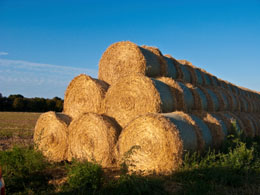A bundle of straw tightly bound by twine or wire is called a straw bale. Straw bale gardening involves the usage of these bales in place of the more traditional method of using soil.

Bunches of straw tightly bound can serve as great hosts for growing plants. Gardening through this technique is very helpful for those who have knee problems or do not want to create a mess which comes with soil gardening.
The Varied Techniques
Method 1
To start off, you need to have good and
strong straw bales in place. After you decide on the number of bales to use, place them in the desired spot. Arrange the bales together in rows such that the strings are on the ground. This arrangement should resemble a raised bed garden.
The spot, on turning wet, could become messy. For the first three days water the bales twice a day. From day 4 to 7, the bales will heat up and start decomposing. If by any chance the bales sprout, it's not a problem. Just trim the bales using scissors or a knife. After the 7th day, place a layer of weed resistant, compost soil on top of the bales. Now plant your seeds or transplants. In case of plants, keep a trowel handy to push the soil enough to keep your plants in the bales. Take care that the strings do not break while doing this. Along with the soil, use something like a mild fertilizer or chemical which will complement the growth of the plant and nutrients in the soil.
Method 2
In the second method, the initial steps remain the same, however, from day 4 to 6, sprinkle a single bale per day with half a cup of ammonium nitrate. Then water the bales well. From day 7 to 9 reduce the amount of ammonium to one-fourth cup. Water the bales again. On the 10th day, add a cup of fertilizer per bale and don't forget to water. Once this is over, transfer the plant in the bales by making a wedging in a bale for each plant. For the best possible growth, place the plant down to its first leaf and close the crack as much as possible. This specific method is suitable for vegetable gardens, especially those vegetables which grow above the surface.
Make sure that you water the bales everyday as it is necessary to keep the bales damp. Another important thing is that it can accommodate as many plants (if not more) when compared to traditional gardening. The best part about this technique is that it keeps the weeds away.






 Bunches of straw tightly bound can serve as great hosts for growing plants. Gardening through this technique is very helpful for those who have knee problems or do not want to create a mess which comes with soil gardening.
Bunches of straw tightly bound can serve as great hosts for growing plants. Gardening through this technique is very helpful for those who have knee problems or do not want to create a mess which comes with soil gardening.